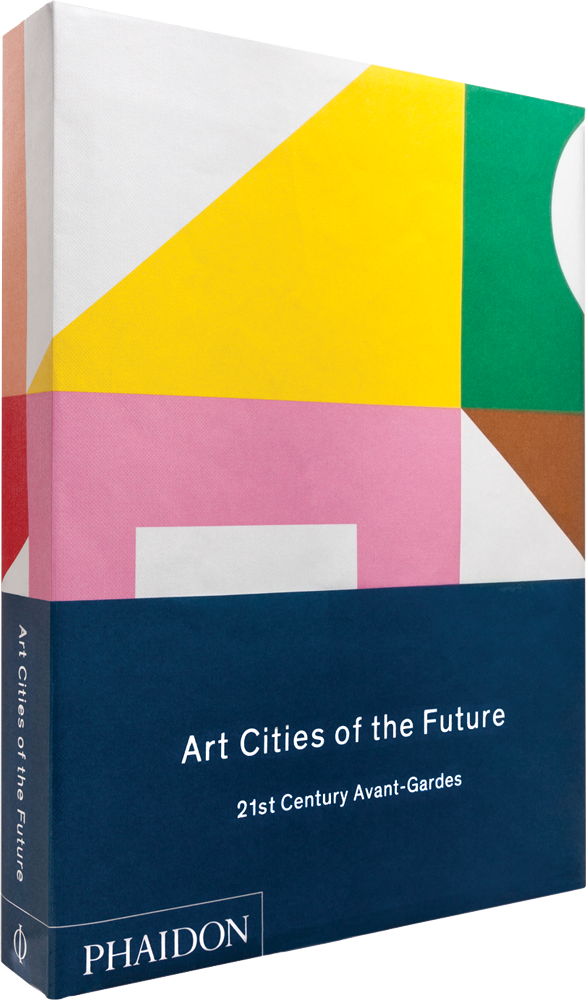As weather cools across the country, it feels like there’s no better time to curl up indoors with a good book. Here are some titles that we recommend.
Art Cities of the Future: 21st Century Avant-Gardes, Kaelan Wilson-Goldie, José Roca, Jane Neal et al., Phaidon, 336 pp, $79.95.
The art world’s current relationship with place is paradoxical (some might say hypocritical). Documenta 13, for instance, elided place entirely in its presentation of artists, yet its outposts appear to have been chosen carefully, arguably for their seemingly obscure qualities. Indeed, in an art world that claims to be more heterogenous and boundary-less than ever before, place still matters, both conceptually and, more cynically, commercially—as this new volume from Phaidon attests. So, what are the art cities of the future? According to the book’s editors and curators, they are not London, New York or Paris. Some selections are unexpected (smaller cities like Cluj, Romania, and San Juan, Puerto Rico); others, such as Istanbul and São Paulo (the former with a burgeoning biennial, the latter with an established one) seem more germane. Vancouver—puzzlingly, long known as an art centre—is also here, with an essay by Reid Shier praising the city’s “hybrid spaces” and “critical and visual discourse.”
Forrest Bess: Key to the Riddle, Chuck Smith, Powerhouse Books, 168 pp, $46.00.
Chuck Smith’s book is published in tandem with a monograph from the Menil Collection, whose recent exhibition of the late Texan’s paintings was the first retrospective in more than 20 years. Smith, who made a documentary about Bess in 1999, offers an intimate view, telling of the artist’s life through original documents. Journals, jottings and letters, including ones to art critic Meyer Schapiro and Bess’s gallerist Betty Parsons, provide insight into a complex aesthetic philosophy as well as into the radical surgery Bess administered on himself to become a hermaphrodite. A prelude, one hopes, to a Collected Letters and Journals of Forrest Bess.
Glamour is Theft: A User’s Guide to General Idea, Philip Monk, Art Gallery of York University, 256 pp, $40.00.
As critic and curator, Philip Monk has had a close and at times contentious relationship with the work of General Idea (a.k.a. Felix Partz, Jorge Zontal and AA Bronson). This book, which follows a reprisal of two key 1970s GI exhibitions at the Art Gallery of York University in 2009, cements his position as the collective’s leading interpreter and chief mythologizer. Indeed, as Monk explains, any attempt to disentangle fact from fiction in GI’s work offers yet another instance of the group’s core conceptual stratagem: a perpetual return to myth itself.
The Painting Project: A Snapshot of Painting in Canada, Louise Déry, Julie Bélisle, Robert Enright et al., Galerie de l’UQAM, 364 pp, $50.00.
From the Group of Seven to the Automatistes and the Painters Eleven, painting occupies a significant place in Canadian art history. This richly illustrated, bilingual catalogue accompanies a two-part exhibition on view earlier this year at Montreal’s Galerie de l’UQAM. Works by 60 artists are reproduced, alongside essays on topics ranging from collecting painting in a national art institution to the current state of painting in Quebec, testifying to the dynamism and diversity of work being made in studios from St. John’s to Victoria.
Bad Boy: My Life on and off the Canvas, Eric Fischl and Michael Stone, Crown Publishers, 357 pp, $31.00.
Artists’ autobiographies often tend towards the Bildungsroman: narratives of personal growth that culminate in the protagonist’s latest achievements. But Fischl’s take on the genre—which intersperses the painter’s diaristic reflections with family snapshots, reproductions of his work and commentary from family and friends—strays from this formula, voicing a rare ambivalence about his rise and fall in New York’s art world. “All artists have to find ways to lie to themselves,” he writes, but few do it so candidly.
Animals with Sharpies, Michael Dumontier and Neil Farber, Drawn & Quarterly, 64 pp, $16.95.
A Canadian classic is born. Farber and Dumontier, two of the founding members of Winnipeg’s Royal Art Lodge, have put their heads together to bring readers the secret inner life of some of North America’s favourite and familiar animals, who express their thoughts with mouth-held Sharpies. Kenneth Grahame and The Wind in the Willows, move over. With deft and funny illustrations, Edwardian prose gets supplanted by 21st-century vernacular. A broad-snouted bear scrawls, “I didn’t come from no monkey.” An angry rat writes, “Dear cat asshole, How would you like it if I ate your husband?” An amorous snake opines: “Baby, unhook your jaw I wanna crawl inside you.” And we believe it all.
100 Masters: Only in Canada, Stephen Borys with Andrew Kear, Winnipeg Art Gallery, 275 pp, $71.75.
Stephen Borys is a gallery director with energy, and for the WAG’s 100th anniversary as the first civic art gallery in Canada, he has produced a volume collecting some of the standout works in other public galleries across the country. It is a well-written, well-illustrated gem. In it you learn, for instance, that you don’t need to go to Tate Britain in London to see an important L.S. Lowry work; you can go to the Beaverbrook Art Gallery in Fredericton, which holds his remarkable Beach Scene, Lancashire (1947).
This article is drawn from the Fall 2013 issue of Canadian Art. To read more from this issue, visit its table of contents, or check out our iPad edition.









